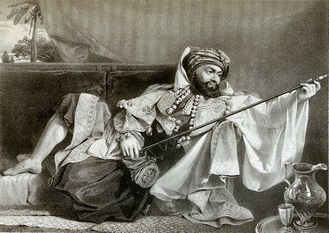
A Narrative of Travels in Northern Africa, in the Years 1818, 19, and 20, Accompanied by Geographical Notices of Soudan, and of the Course of the Niger. London: John Murray, 1821. Gift of James Freeman. [Rare Books Division]
Strong in thy strength I go, and whereso'er
My steps may wander, may I ne'er forget
All that I owe to thee; and O may ne'er
My frailties tempt me to abjure that debt!
And what, if far from thee my star shall set,
Hast thou not hearts that shall with sadness hear
The tale, and some fair cheeks that shall be wet,
And some bright eyes, in which the swelling tear
Shall start for him who sleeps in Afric's deserts drear.
—Joseph Rictchie, from "A Farewell to England" [see note below]
One of a few veterans of both African and Arctic expeditions, Lyon is remembered today for his competent drawings of local scenes and people. He was a British naval officer stationed in Malta when, in September 1818, Joseph Ritchie (1788?-1819) arrived on his way to Tripoli and the interior of Africa on an expedition commissioned by the British government. (A surgeon in London, Ritchie had made the acquaintance of poet John Keats and—perhaps by some association of “Endymion” with the Mountains of the Moon—had agreed to take a copy of Keats’s poem with him to “fling” into the heart of the Sahara. Before leaving, Ritchie himself had written “A Farewell to England,” a poem in Spencerian stanzas in which the speaker anticipates his death in “Afric’s desarts.”) When Ritchie’s original partner was prevented from joining, Lyon seized the opportunity to volunteer his services.
The expedition was charged to find and chart the course of the Niger River via the Sahara. After long delays, the group proceeded from Tripoli in March 1819 and reached Murzuq, the capital of the Fezzan part of Libya, in thirty-nine days. Underfinanced, poorly supplied, and burdened with ill-selected merchandise that proved unsalable, the expedition foundered. Both men, particularly Ritchie, got very sick. (Detailed tables kept by Lyon show that temperatures reached 133° Fahrenheit several times during their time there.) Ritchie died in November; Lyon, still feeble, pushed to the southern boundary of the Fezzan, but had to turn back. He arrived in Tripoli more dead than alive in March 1820. The anecdotal evidence he had gathered from Arab travelers and traders suggested that the Niger emptied into a lake Tsad (Lake Chad) and from there reached the Nile—conclusions that would be refuted in subsequent expeditions.